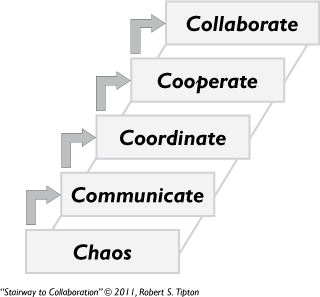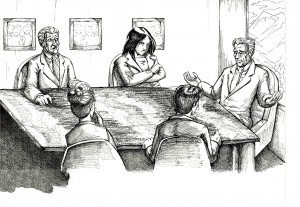“Any problem, big or small, within a family, always seems to start with bad communication. Someone isn’t listening.” Emma Thompson
If I had $1 for every time I’ve heard the word “collaborate” in the past five years, I’m sure the Tipton family college fund (two more kids to go!) would be fully funded. I hear “let’s collaborate about that” ALL the time.
Also, as anyone who knows me can attest, words matter to me. Therefore, please don’t say the word “collaborate” in my presence unless you REALLY mean it. In fact, if you’ve ever been in one of my workshops when someone uses the word “collaborate,” I’ll stop the workshop, and we’ll have a short “leadership moment” where I’ll bring a clearer understanding about the word.
(Some of you know what I’m saying – you’ve been in one of my sessions.)
No doubt, you too can access dictionary.com and get a good definition of what it means to collaborate, but let me give you the definition from the “Standard Tipton Dictionary”:
Collaboration is the highest, most trust-filled form of group or team interaction.
Roll that around for a minute.
The highest… Most trust-filled…
Now, I KNOW that’s NOT what most people mean when they use the word. What do you most likely mean when you say “collaborate?” I think most people mean one of three other things. But I get ahead of myself – let me back up a second, and start at the beginning.
If collaboration is the highest level of interaction between and among people, what precedes it? With full apologizes to Led Zeppelin, I use “The Stairway to Collaboration” graphic below to help make my point:

Step 0: Chaos
Chaos is the absence of communication; the lack of structured interaction of any kind between and among individuals, groups, teams, or entire enterprises. Think “Afghanistan pre-2001”, or “Somalia”, or a group of 5 year olds playing soccer. It may “look” like there’s a LOT of talking, and things like emails, voice messages, Facebook status updates, tweets, etc. might be flying around, but there’s no communication. Why? Because no one cares whether or not their intended messages are actually received and understood by anyone. They’re just throwing out messages into the air and expecting others to “get it.” Or worse yet, they’re lobbing bombs or shooting bullets – real or metaphorical.
Step 1: Communicate
Okay – so the next step up the stairway involves some form of actual communication. We use tools like email, voicemail, portals, tweets, blogs, Facebook pages, etc. However, at this level on the stairway we still tend to use our own preferred method of communicating (you know – some people are phone advocates, others love email, while another group – like me – prefers real human contact without any electronic intermediaries involved. There’s no substitute for a REAL handshake, and an non-electronic look in the eye.
Another dynamic with “communicate” is that most interaction at this level is one-way: I speak, I expect you to listen. Think annual performance reviews, monthly staff meetings, etc. We’re communicating with each other, but the interaction is pretty one-sided. It’s like this quote from Margaret Miller: “Most conversations are simply monologues delivered in the presence of a witness.” Yikes! But, that’s often true wouldn’t you agree?
Step 2: Coordinate
To coordinate with someone else (or another group, team or enterprise) means to actively make the decision not to get in each other’s way. Think about scheduling meetings using Exchange calendars, or scheduling meeting rooms, etc. When it’s done well, we use these tools to ensure we’ve coordinated schedules — and haven’t overlapped, left-out, or double-booked anyone or anything.
In other words, we’ve taken our interaction one step forward — where we are interested seeing what someone else is doing, and then making sure we don’t conflict with it. In addition, at the coordinate level, we’re starting to have some bi-directional communication using a variety of tools. I’m still using the tool that’s most comfortable to me (like email) most often, but occasionally I may stop by your cube (or office) to see you if I know you prefer face-to-face. At least I’m thinking about it.
Step 3: Cooperate
Cooperation is the process of actively looking to be helpful — sharing information, looking to assist each other, finding ways to be highly effective in our communication. Effective communication is defined this way (again, from the Tipton Standard Dictionary): “Our intended messages are received and understood by the recipient.” In other words, we look to share in the ways and using the tools our audience prefers. For example, if you want to have a cooperative communication with your teenager, I highly recommend you produce and post a YouTube video. It’s how teenagers experience the world – through video. It may not be YOUR preferred means of communication, but it is theirs. You will have a MUCH higher potential that they’ll not only listen, but they’ll understand. Isn’t that the point??
Cooperative relationships are trust-based, and show positive energy. But, in cooperating with each other we stop short of “owning” each other’s issues and challenges — cooperation just isn’t that robust. That’s where collaboration comes in. It takes cooperation and accelerates it times ten.
Step 4: Collaborate
Well, we’ve finally made it to “collaborate…” (At least we’ve made it there on the chart). However, in my experience in working with enterprises, teams and groups of all sizes and shapes, I encounter TRUE collaboration not quite as rarely as the wild Himalayan Yeti, but almost.
Why?
Because it takes months and years of dedication, of trust-building, of holding each other accountable, of looking out for each other’s best interests, of assuming best intentions to get to collaboration. It’s truly a win-win situation because in a collaborative relationship, I own your problems if they were my problems – and you LIKE that. There’s no dysfunctional egos involved, no “I’d better get while the getting is good,” no competition, no jealousy, no envy, no first, second, or third place. We look around each other’s corners and over each other’s hills. We look out for each other. For real.
Now do you see why I see real collaboration so rarely?
What Now?
So… Given my definitions above, why do you think so many of us use the word collaborate when we mean something different?
My experience tells me that it “sounds” bigger and more important to say “let’s collaborate” rather than using collaborate’s “lesser” cousins of communicate, coordinate or cooperate.
“Let’s coordinate” just lacks pizzazz. Don’t you agree? Yes?
However, it’s far more accurate to say “coordinate” most of the time. Let’s start with good communication, move toward and beyond coordination, and even get cooperative sometimes in our organizational lives. Let’s also leave room – every now and then – for the spark of collaboration to make its way in.
And that’s when the magic happens. It’s the place where work is effortless, where team MEANS something, where results are extraordinary, and where the energy is power-filled, positive, and clean.
So… Do you still want to say you’re feeling collaborative?
Not so fast… It’s going to take some work, some trust, some time, and some real relationship “stuff” to come forward.
Then again, it’s worth it. It’s wonderful.





4 Responses to “Feeling Collaborative? NOT SO FAST!”